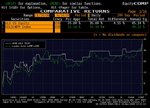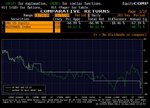I have been wondering for a while how the ETF's that track indicies maintin a comparable price for the index or commodity they follow. I'm talking mainly about the SPY (S&P 500 spider), GLD (gold), UNG (US Natural Gas Fund), and USO (US Oil fund).
With a stock, the price is formed strictly by supply/demand. With these ETF's, there is a supply/demand market, but they also must maintain a relationship with the index or commodity they are tied to. Can anyone explain this to me?
Thanks, Brad.
With a stock, the price is formed strictly by supply/demand. With these ETF's, there is a supply/demand market, but they also must maintain a relationship with the index or commodity they are tied to. Can anyone explain this to me?
Thanks, Brad.




